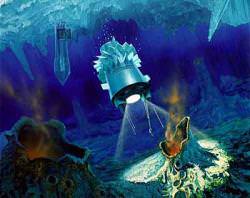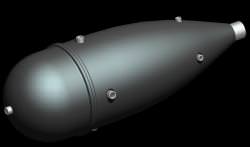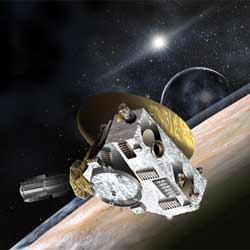Many planetary scientists believe that Jupiter’s moon Europa is our solar system’s best contender to share Earth’s distinction of harboring life. Evidence gathered by the Voyager and Galileo spacecrafts suggests Europa contains a deep, possibly warm ocean of salty water under an outer shell of fissured ice. In a paper published in the July 2007 Journal of Aerospace Engineering a British mechanical engineer proposes sending a submarine to explore Europa’s oceans.
Carl T. F. Ross, a professor at the University of Portsmouth in England offers an abstract design of an underwater craft built of a metal matrix composite. He also provides suggestions for suitable power supplies, communication techniques and propulsion systems for such a vessel in his paper, “Conceptual Design of a Submarine to Explore Europa’s Oceans.”
Ross’s paper weighs the options for constructing a submarine capable of withstanding the undoubtedly high pressure within Europa’s deep oceans. Scientists believe that this moon’s oceans could be up to 100 kilometers deep, more than ten times deeper than Earth’s oceans. Ross proposes a 3 meter long cylindrical sub with an internal diameter of 1 meter. He believes that steel or titanium, while strong enough to withstand the hydrostatic pressure, would be unsuitable as the vessel would have no reserve buoyancy. Therefore, the sub would sink like a rock to the bottom of the ocean. A metal matrix or ceramic composite would offer the best combination of strength and buoyancy.
Ross favors a fuel cell for power, which will be needed for propulsion, communications and scientific equipment, but notes that technological advances in the ensuing years may provide better sources for power.
Ross concedes that a submarine mission to Europa won’t occur for at least 15-20 years. Planetary scientist William B. McKinnon agrees.

“It is difficult enough, and expensive, to get back to Europa with an orbiter, much less imagine a landing or an ocean entry,” said McKinnon, professor of Earth and Planetary Sciences at Washington University in St. Louis, Missouri. “Sometime in the future, and after we have determined the ice shell thickness, we can begin to seriously address the engineering challenges. For now, it might be best to search for those places where the ocean has come to us. That is, sites of recent eruptions on Europa’s surface, whose compositions can be determined from orbit.”
The Jet Propulsion Laboratory is currently working on a concept called the Europa Explorer which would deliver a low orbit spacecraft to determine the presence (or absence) of a liquid water ocean under Europa’s ice surface. It would also map the distribution of compounds of interest for pre-biotic chemistry, and characterize the surface and subsurface for future exploration. “This type of mission,” says McKinnon, “would really allow us to get the hard proof we would all like that the ocean is really there, and determine the thickness of the ice shell and find thin spots if they exist.”
McKinnon added that an orbiter could find “hot spots” that indicate recent geological or even volcanic activity and obtain high-resolution images of the surface. The latter would be needed to plan any successful landing.
Slightly smaller than Earth’s moon, Europa has an exterior that is nearly craterless, meaning a relatively “young” surface. Data from the Galileo spacecraft shows evidence of near-surface melting and movements of large blocks of icy crust, similar to ice bergs or ice rafts on Earth.
While Europa’s midday surface temperatures hover around 130 K (-142 C, -225 degrees F), interior temperatures could be warm enough for liquid water to exist underneath the ice crust. This internal warmth comes from tidal heating caused by the gravitational forces of Jupiter and Jupiter’s other moons which pull Europa’s interior in different directions. Scientists believe similar tidal heating drives the volcanoes on another Jovian moon, Io. Seafloor hydrothermal vents have also been suggested as another possible energy source on Europa. On Earth, undersea volcanoes and hydrothermal vents create environments that sustain colonies of microbes. If similar systems are active on Europa, scientists reason that life might be present there too.
Among scientists there is a big push to get a mission to Europa underway. However this type of mission is competing for funding against NASA’s goal of returning to our own moon with human missions. The proposed Jupiter Icy Moon Orbiter (JIMO) a nuclear powered mission to study three of Jupiter’s moons, fell victim to cuts in science missions in NASA’s Fiscal Year 2007 Budget.
Ross has been designing and improving submarines for over 40 years, but this is the first time he’s designed a craft for use anywhere but on Earth.
“The biggest problem that I see with the robot submarine is being able to drill or melt its way through a maximum of 6 km of the ice, which is covering the surface,” said Ross. “However, the ice may be much thinner in some places. It may be that we will require a nuclear pressurized water reactor on board the robot submarine to give us the necessary power and energy to achieve this”
While Ross proposes using parachutes to bring the submarine to Europa’s surface, McKinnon points out that parachutes would not work in Europa’s almost airless atmosphere.
Ross has received very positive responses to his paper from friends and colleagues, he says, including notable British astronomer Sir Patrick Moore. Ross says his life has revolved around submarines since 1959 and he finds this new concept of a submarine on Europa to be very exciting.
McKinnon classifies the exploration of Europa as “extremely important.”
“Europa is a place is where we are pretty sure we have abundant liquid water, energy sources, and biogenic elements such as carbon, nitrogen, sulfur, phosphorus, etc,” he said. “Is there life, any kind of life, in Europa’s ocean? Questions don’t get much more profound.”
Written by Nancy Atkinson


